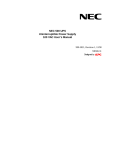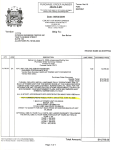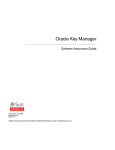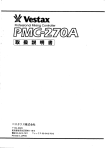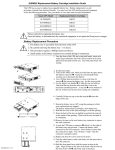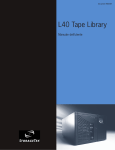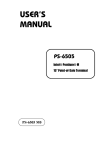Download StorageTek L180 User's Manual
Transcript
Document 96047 L180 and L700 Tape Library Uninterruptible Power Supply Reference Manual L180 and L700 Tape Library Uninterruptible Power Supply Reference Manual First Edition (June 2001) This edition contains 56 pages. See “Summary of Changes” on page v for the revision history and summary of changes made to this document. The information contained in this document is subject to change without notice. Storage Technology Corporation assumes no responsibility for any errors that may appear. In the event of changes, the publication will be revised. Comments concerning its contents should be directed to: Information Development Storage Technology Corporation One StorageTek Drive Louisville, CO 80028-2201 USA A Reader’s Comment Form at the back of this publication is for communicating suggestions and requests for change. We encourage and appreciate your feedback. StorageTek, the signature, and Information Made Powerful are trademarks of Storage Technology Corporation. Other product names, features, and terms used in this publication are for informational purposes only and might be trademarks of Storage Technology Corporation or of other companies. No part of this publication may be reproduced or distributed in any form or by any means, or stored in a database or retrieval system, without the prior written consent of Storage Technology Corporation. Storage Technology Corporation makes no warranties, express or implied, by operation of law or otherwise, relating to this document, or the products described herein. STORAGE TECHNOLOGY CORPORATION DISCLAIMS ALL IMPLIED WARRANTIES OF MERCHANTIBILITY AND FITNESS FOR A PARTICULAR PURPOSE. In no event shall Storage Technology Corporation be liable for (a) incidental, indirect, special, or consequential damages or (b) any damages whatsoever resulting from the loss of use, data or profits, arising out of this document, even if advised of the possibility of such damages. Copyright © 2001 by Storage Technology Corporation, Louisville, CO, USA. All rights reserved. Printed in USA. ii First Edition 96047 Contents Contents . . . . . . . . . . . . . . . . . . . . . . . . . . . . . . . . . . . . . . . . . . . . . . . . . . . . . . . . iii Summary of Changes . . . . . . . . . . . . . . . . . . . . . . . . . . . . . . . . . . . . . . . . . . . . . . . v Preface . . . . . . . . . . . . . . . . . . . . . . . . . . . . . . . . . . . . . . . . . . . . . . . . . . . . . . . . . vii Organization . . . . . . . . . . . . . . . Comments and Suggestions . . . . Alert Messages . . . . . . . . . . . . . . Related Publications . . . . . . . . . . Additional Information . . . . . . . . StorageTek’s External Web Site Customer Resource Center . . Hardcopy Publications . . . . . . . . . . . . . . . . .. .. . . . . . . . . . . . . . . . . . . . . . . . . . . . . . . . . . . . . . . . . . . . . . . . . . . . . . . . . . . . . . . . . . . . . . . . . . . . . . . . . . . . . . . . . . . . . . . . . . . . . . . . . . . . . . . . . . . . . . . . . . . . . . . . . . . . . . . . . . . . . . . . . . . . . . . . . . . . . . . . . . . . . . . . . . . . . . . . . . . . . . . . . . . . . . . . . . . . . . . . . . . . . . . . . . . . . . . . . . . . . . . . . . . . . . . . . . . . . . . . . . . . . . . . . . . . . . . . . . . . . . . . . . . . . . . . . . . . . . . . . . . . . . . . . . . . . . . . . .vii .vii viii viii . ix . ix . ix . ix Safety Precautions . . . . . . . . . . . . . . . . . . . . . . . . . . . . . . . . . . . . . . . . . . . . . . . . . x Battery Safety . . . . . . . . . . . . . . . . . . . . . Door Interlock . . . . . . . . . . . . . . . . . . . . Electrostatic Discharge Damage Prevention Rack Safety and Precautions . . . . . . . . . . L180 Temperature Recommendations . L700 Temperature Recommendations . ... ... .. ... ... ... . . . . . . . . . . . . . . . . . . . . . . . . . . . . . . . . . . . . . . . . . . . . . . . . . . . . . . . . . . . . . . . . . . . . . . . . . . . . . . . . . . . . . . . . . . . . . . . . . . . . . . . . . . . . . . . . . . . . . . . . . . . . . . . . . . . . . . . . . . . . . . . . . . . . . . . . . . . . . . . . . . . . . . . . . . . . . . . . . . . . . x . x . xi . xi xiii xiv 1: General Information . . . . . . . . . . . . . . . . . . . . . . . . . . . . . . . . . . . . . . . . . . .1-1 Introduction . What it Does Feature Codes Installation . . Service . . . . . .......... .......... ......... .......... .......... .......... .......... .......... .......... .......... ......... ......... ......... ......... ......... .......... .......... .......... .......... .......... .......... .......... .......... .......... .......... ..... ..... ..... ..... ..... 1-1 1-1 1-2 1-2 1-2 2: Controls and Indicators . . . . . . . . . . . . . . . . . . . . . . . . . . . . . . . . . . . . . . . . .2-1 UPS Indicators . . . . . . . . . . . . . . . . . . . . . . . . . . . . . . . . . . . . . . . . . . . . . . . . . . . . . 2-1 Redundant Switch Indicators . . . . . . . . . . . . . . . . . . . . . . . . . . . . . . . . . . . . . . . . . . . 2-3 3: Installation Overview . . . . . . . . . . . . . . . . . . . . . . . . . . . . . . . . . . . . . . . . . . .3-1 Prerequisites . . . . . . . . . . UPS Feature Codes . . . Rack Cooling Feature . Rear Door Replacement 96047 .... .... .... ... . . . . . . . . . . . . . . . . . . . . . . . . . . . . . . . . . . . . . . . . . . . . . . . . First Edition . . . . . . . . . . . . . . . . . . . . . . . . . . . . . . . . . . . . . . . . . . . . . . . . . . . . . . . . . . . . . . . . . . . . . . . . . . . . . . . . . . . . . . . . . . . . . . . . . . . . . . . . . . . . . . . . 3-1 3-1 3-1 3-2 iii Contents Power Connections . . . . . . . . . Before Beginning . . . . . . . . . . . . . Instructions . . . . . . . . . . . . . . . . . APC Web/SNMP Management Card Operation . . . . . . . . . . . . . . . . . . Self-Test . . . . . . . . . . . . . . . . . Charge the Battery . . . . . . . . . Voltage Sensitivity . . . . . . . . . . Low Battery Warning . . . . . . . . . . . . . . . . . . . . . . . . . . . . . . . . . . . . . . . . . . . . . . . . . . . . . . . . . . . . . . . . . . . . . . . . . . . . . . . . . . . . . . . . . . . . . . . . . . . . . . . . . . . . . . . . . . . . . . . . . . . . . . . . . . . . . . . . . . . . . . . . . . . . . . . . . . . . . . . . . . . . . . . . . . . . . . . . . . . . . . . . . . . . . . . . . . . . . . . . . . . . . . . . . . . . . . . . . . . . . . . . . . . . . . . . . . . . . . . . . . . . . . . . . . . . . . . . . . . . . . . . . . . . . . . . . . . . . . . . . . . . . . . . . . . . . . . . . . . . . . . . . . . . . . . . . . . . . . . . . . . . . . . . . . . . . . . . . . . . . . . . . . . . . 3-2 3-2 3-3 3-6 3-6 3-6 3-6 3-7 3-7 4: Fault Isolation . . . . . . . . . . . . . . . . . . . . . . . . . . . . . . . . . . . . . . . . . . . . . . . . .4-1 UPS is On . . . . . . . . . . . . UPS is Off . . . . . . . . . . . . UPS is Not Communicating Battery Needs Replacement View Event Log . . . . . . . . Troubleshooting the UPS . Battery Replacement . . . . . Battery Safety . . . . . . . Instructions . . . . . . . . .......... .......... .......... ......... .......... .......... .......... .......... .......... ......... ......... ......... ......... ......... ......... ......... ......... ......... .......... .......... .......... .......... .......... .......... .......... .......... .......... .......... .......... .......... .......... .......... .......... .......... .......... .......... ..... ..... ..... ..... ..... ..... ..... ..... ..... 4-2 4-3 4-4 4-5 4-6 4-7 4-9 4-9 4-9 5: Service . . . . . . . . . . . . . . . . . . . . . . . . . . . . . . . . . . . . . . . . . . . . . . . . . . . . . . .5-1 Customer Support Services . . . . . . . . . . . . . . . . . . . . . . . . . . . . . . . . . . . . . . . . . . . . 5-1 Service Procedures . . . . . . . . . . . . . . . . . . . . . . . . . . . . . . . . . . . . . . . . . . . . . . . . . . 5-2 StorageTek’s Worldwide Offices . . . . . . . . . . . . . . . . . . . . . . . . . . . . . . . . . . . . . . . . 5-2 A: Specifications . . . . . . . . . . . . . . . . . . . . . . . . . . . . . . . . . . . . . . . . . . . . . . . . . A-1 Uninterruptible Power Supply . . . . . . . . . . . . . . . . . . . . . . . . . . . . . . . . . . . . . . . . . . A-1 Redundant Switch . . . . . . . . . . . . . . . . . . . . . . . . . . . . . . . . . . . . . . . . . . . . . . . . . . A-3 Outlet Strip . . . . . . . . . . . . . . . . . . . . . . . . . . . . . . . . . . . . . . . . . . . . . . . . . . . . . . . A-3 Glossary . . . . . . . . . . . . . . . . . . . . . . . . . . . . . . . . . . . . . . . . . . . . . . . . . Glossary-1 Index . . . . . . . . . . . . . . . . . . . . . . . . . . . . . . . . . . . . . . . . . . . . . . . . . . . . . . .Index-1 Reader’s Comment Form iv First Edition 96047 Summary of Changes EC Number Date Edition Description 111657 June 2001 First Initial release. 96047 First Edition v Summary of Changes This page intentionally left blank. vi First Edition 96047 Preface StorageTek offers an uninterruptible power supply (UPS) as an optional feature for protecting the L180 and L700 Tape Libraries. This reference manual contains information about the UPS with an overview about how to install it and how to service it if there is a problem. The information in this manual is for anyone interested in this optional feature. Note: This document is a supplement to the StorageTek conversion bills and APC publications. Refer to those documents for specific information. ■ Organization The organization of this manual is: Chapter 1 “General Information” provides an overview about this feature. Chapter 2 “Controls and Indicators” describes the indicators on the UPS. Chapter 3 “Installation Overview” outlines the installation tasks. Chapter 4 “Fault Isolation” assists in isolating problems with the UPS. Chapter 5 “Service” describes how to contact StorageTek if problems exist. Appendix A “Specifications” lists the specifications for this feature. Glossary Defines new or special terms and abbreviations in this manual. Index Assists in locating information in this manual. ■ Comments and Suggestions A Reader’s Comment Form at the back of this publication lets you communicate suggestions or requests for change. StorageTek encourages and appreciates reader feedback. StorageTek employees with Intranet access may complete an online Reader’s Comment Form. The URL is: http://gandalf/sts/nid/idrcf2.htm 96047 First Edition vii Preface ■ Alert Messages Alert messages call the reader’s attention to information that is especially important or that has a unique relationship to the main text or graphic. Note: A note provides additional information that is of special interest. A note might point out exceptions to rules or procedures. A note usually, but not always, follows the information to which it pertains. CAUTION: A caution informs the reader of conditions that might result in damage to hardware, corruption of data, corruption of application software, or longterm health problems in people. A caution always precedes the information to which it pertains. WARNING: A warning alerts the reader to conditions that might result in injury or death. A warning always precedes the information to which it pertains. ■ Related Publications The following publications contain additional information: Tape Library Publications Part Number L180 Tape Library Operator’s Guide 95895 L700 Tape Library Hardware Operator’s Guide 95845 L180/L700 Tape Libraries General Information Manual MT 9111 L180/L700 Tape Library Ordering and Configuration Guide MT 9112 APC Publications APC Uninterruptible Power Supply manuals are shipped with the equipment or go online at www.apcc.com for more information. viii First Edition 96047 Preface ■ Additional Information StorageTek offers several methods for you to obtain additional information. Use one of the following when you want to obtain additional information or to get the latest edition of any StorageTek publication. StorageTek’s External Web Site StorageTek’s external web site provides marketing, product, corporate, and service information. In addition, the external web site serves as an entry point to the Customer Resource Center and to the Channel site. The external web site is accessible to anyone with a web browser and an Internet connection. The URL for StorageTek’s external web site is http://www.storagetek.com Customer Resource Center StorageTek’s Customer Resource Center (CRC) web site enables members to resolve technical issues by searching code fixes and technical documentation. CRC membership entitles you to other proactive services, such as HIPER subscriptions, technical tips, answers to frequently asked questions, and online product support contact information. Customers who have a current warranty or a current maintenance service agreement may apply for membership by clicking on the Request Password button on the CRC home page. StorageTek employees may enter the CRC through PowerPort. The URL for the CRC is http://www.support.storagetek.com. Hardcopy Publications You may order hard copies of publications listed on the Customer Resource Center or Documents on CD. Service publications have numeric part numbers. To order hard copies of service publications, contact your local Customer Services Logistics Depot. Marketing publications have alphanumeric part numbers. To order hard copies of marketing publications, do one of the following: • Visit the StorageTek’s PowerPort and select alphabetical listings under “L” or select Online Forms. Then search for Literature Distribution. Follow the instructions on the Literature Distribution web page. • Send an e-mail to Literature Distribution at [email protected]. Note: If you are a StorageTek customer, please contact a StorageTek representative to help you obtain copies of StorageTek publications. 96047 First Edition ix Safety Precautions Safety Precautions Please read and observe the following safety topics for this product. CAUTION: Potential injury: On-the-job safety is important; therefore, observe the following safety precautions while you are engaging in any maintenance or installation activity. Failing to follow these precautions could result in serious injury. • Remove all conductive jewelry, such as watches and rings, before you service powered-on equipment. • Avoid electrical shock. Be careful when you work near power connectors and supplies. • Power-off the equipment that is being serviced (unless otherwise stated). Remember that dangerous voltages could still be present in some areas even though power is off. • Enforce good housekeeping practices in the equipment area to help prevent fire and accidents. • Do not lift heavy loads without assistance. Note: The batteries are heavy and require two people to lift and install them. ■ Battery Safety • The UPS contains potentially hazardous voltages. Do not attempt to disassemble the unit. The only exception is when replacing the batteries— battery replacement is permissible. • Except for the battery, the unit contains no user serviceable parts. Repairs are performed only by factory trained service personnel. • Do not dispose of batteries in a fire. The batteries may explode. • Do not open or damage the batteries. They contain an electrolyte which is toxic and harmful to the skin and eyes. • Replace the batteries with the same part number and type as the original. ■ Door Interlock A safety interlock for the tape library is located behind the front door. When the door is opened, the interlock immediately disables all tape library motors. x First Edition 96047 Safety Precautions ■ Electrostatic Discharge Damage Prevention Before you touch any internal components in the library, including drives, you must take precautions against electrostatic discharge (ESD). CAUTION: Components are sensitive to static electricity: Even a small electrostatic discharge can damage an electrical component that is inside the library. A damaged component might not fail immediately, but over time, it will become worse and might eventually cause an “intermittent” problem. Be sure that you touch an unpainted metal surface of the library before you reach inside the library or touch the drives. Before you touch any internal components: 1. With your finger, touch an unpainted metal surface of the library. In some libraries, you can touch the library’s frame. In other libraries, you might have to touch a bolt on the wall or on the door frame. 2. Keep your body movement to a minimum as you touch library components. Note: Antistatic wrist straps that have clip-on ends are commercially available. ■ Rack Safety and Precautions WARNING: Possible personal injury: • More than one person might be required to install equipment into the library’s rack or to remove equipment from the library’s rack. • Personnel should take adequate precautions when they are moving a library that contains rack-mounted equipment. The weight of some rack equipment might alter the height of the library’s center of gravity. This condition might cause the library to tip during a move. CAUTION: Potential equipment damage: Do not exceed the maximum allowable weight and U-height for equipment in the rack area: • • L180 weight is 77 kg (170 lb) and U-height is 6 units. L700 weight is 130 kg (300 lb) and U-height is 17 units. Observe the following when you are installing equipment into the library’s rack: • 96047 Ensure that the equipment has UL listing (listing by Underwriters’ Laboratories), CSA certification (certification by the Canadian Standards Association), and CE compliance (compliance with the European Council’s directives and standards). First Edition xi Safety Precautions • Understand that the library does not supply power to the rack area. So ensure that the rack-mounted equipment has an adequate power source. • Follow the manufacturer’s guidelines to position, to support, and to fasten the equipment in the rack. • Locate the equipment so that it does not block or hinder any ventilation openings in the library’s rack area. For example, do not block library or drive exhaust areas, the electronic module exhaust area, perforated metal, or other similar ventilation. • Locate the equipment so that the library’s doors adequately clear the equipment when you close them. • Install the equipment from the bottom of the rack to the top of the rack; StorageTek recommends that you place the heaviest items near the bottom of the rack. • Ensure that the equipment in the rack does not create an overcurrent condition, whether equipment is connected directly to the branch circuit or to a power distribution strip. • Ensure that the equipment in the rack has reliable earth ground, whether equipment is connected directly to the branch circuit or to a power distribution strip. • Ensure that any equipment that you place within the rack is adequately cooled. The library’s internal ambient temperature should not exceed the recommended operating temperature. Base your cooling considerations upon the power dissipation within the rack space as well as upon the ambient room conditions that are external to the library. Note: StorageTek offers an optional feature that provides additional cooling for equipment installed in the rack space area. Library L180 L700 Feature Code Description Conversion Bill DFAN Domestic fan, rack area cooling 101331 EFAN International fan, rack area cooling 101332 JFAN Japanese fan, rack area cooling 101331 DFAN Domestic fan, rack area cooling 101323 EFAN International fan, rack area cooling 101324 JFAN Japanese fan, rack area cooling 101323 See the following charts for temperature recommendations in the libraries. xii First Edition 96047 Safety Precautions L180 Temperature Recommendations L180, Recommendations for Equipment Rated to 35 C 0 (89.6 F) 32 0 31 30 29 May Exceed Operating Temperatures 27 0 Room Ambient Temperature ( C) 28 26 25 24 Fan Recommended 23 22 21 20 No Fan Needed 19 18 17 575 600 575 600 550 525 500 475 450 425 400 375 350 325 300 275 250 225 200 175 150 0 125 (59 F) 100 75 50 25 15 0 16 Rack Equipment Power (Watts) L180, Recommendations for Equipment Rated to 40 C 0 (89.6 F) 32 0 31 30 29 May Exceed Operating Temperatures 27 0 Room Ambient Temperature ( C) 28 26 25 Fan Recommended 24 23 22 No Fan Needed 21 20 19 18 17 550 525 500 475 450 425 400 375 350 325 300 275 250 225 200 175 150 125 75 50 100 0 (59 F) 25 15 0 16 Rack Equipment Power (Watts) 96047 First Edition xiii Safety Precautions L700 Temperature Recommendations L700, Recommendations for Equipment Rated to 35 C 0 (89.6 F) 0 32 31 30 29 27 May Exceed Operating Temperatures 0 Room Ambient Temperature ( C) 28 26 25 24 23 22 21 Fan Recommended 20 19 18 No Fan Needed 17 16 250 275 300 325 350 375 400 425 450 475 500 525 550 575 600 625 650 675 700 725 750 775 800 825 850 875 900 925 950 975 1000 75 100 125 150 175 200 225 0 25 50 15 0 (59 F) Rack Equipment Power (Watts) L700, Recommendations for Equipment Rated to 40 C 0 (89.6 F) 0 32 31 30 29 May Exceed Operating Temperatures 0 Room Ambient Temperature ( C) 28 27 26 25 24 23 Fan Recommended 22 21 20 19 18 No Fan Needed 17 16 825 850 875 900 925 950 975 1000 0 250 275 300 325 350 375 400 425 450 475 500 525 550 575 600 625 650 675 700 725 750 775 800 (59 F) 75 100 125 150 175 200 225 0 25 50 15 Rack Equipment Power (Watts) xiv First Edition 96047 General Information 1 This chapter contains an introduction about the uninterruptible power supplies for StorageTek’s L180 and L700 Tape Libraries. ■ Introduction StorageTek and American Power Conversion (APC) offer an internal uninterruptible power supply (UPS) with full AC redundancy for protecting StorageTek’s L180 and L700 Tape Libraries. The UPS is an optional feature that allows these tape libraries to maintain continuous operation in the event of a power disruption. The UPS also eases the effects of blackouts, brownouts, sags and surges in AC power. The optional feature consists of two uninterruptible power supplies, an Ethernet interface, a redundant switch, and a power outlet strip. • The two power supplies supplement customer utility power during a blackout and provide conditioning by filtering out small fluctuations and disturbances or disruptions in the AC line voltage. • The Ethernet interface allows you to monitor the status of each UPS. • The switch (also called the redundant switch) alternates between the two UPS units to provide continuous power to the library. • The outlet strip allows you to connect up to eight additional components to the UPS. Note: This feature is capable of mounting internally in the rack space of each library. ■ What it Does If an AC power failure occurs, it causes the switch to automatically transfer the load from the customers power source to the UPS without interruption to the tape library. If the UPS battery fails or is discharged, the switch automatically transfers the load to the redundant UPS without interruption. This dual UPS configuration will supply power to the equipment until the customers power is restored or the batteries are discharged. While running on battery power, periodic beeps will sound; this is normal. Press the TEST button to turn off this alarm. If you hear a continuous beep, you have two minutes before the UPS will shutdown. 96047 First Edition 1-1 General Information ■ Feature Codes The UPS is an optional feature available from StorageTek. Table 1-1 lists the library, feature code, and conversion bill number for the UPS: Table 1-1. Feature Codes Library Feature Code L180 RPWR Domestic power switch and UPS 101406 EPWR International power switch and UPS 101407 RPWR Domestic power switch and UPS 101410 EPWR International power switch and UPS 101411 L700 Description Conversion Bill Note: The UPS feature requires the optional rack cooling feature. See Chapter 3 for information about the prerequisites. ■ Installation StorageTek service representatives can install the UPS feature in the libraries. The UPS bundle is drop-shipped by APC (the manufacturer) within 24 hours of the receipt of the order. Use the information in the L180/L700 Tape Library Ordering and Configuration Guide (part number MT9112) to order the library and the desired features including the UPS. See Chapter 3 for an overview of the installation instructions. ■ Service If there is a problem, place a service call to StorageTek’s Call Center. If it is determined that the UPS has failed; the call will be escalated by the Call Center and StorageTek’s Technical Support to APC, who has 7 by 24 coverage. The replacement parts will be sent to the customer site. Notes: • • 1-2 See Chapter 4 for information about how to isolate problems with the UPS. See Chapter 5 for the procedure to place a service call. First Edition 96047 Controls and Indicators 2 This chapter describes the indicators for the uninterruptible power supply (UPS) and the redundant switch. ■ UPS Indicators Figure 2-1 shows and describes the indicators for the UPS: Figure 2-1. UPS Indicators ON/OFF C67338 ON/OFF TEST Press the larger (upper) button to supply power or silence the alarm. Press the smaller (lower) button to turn off power. Online This LED is on when the UPS is supplying customer (utility) power to the equipment (load). On Battery This LED is on during battery operation. During battery operation, the UPS beeps four times every 30 seconds until the UPS goes back online or the battery is discharged. Note: Press the TEST button to turn off this alarm. 96047 First Edition 2-1 Controls and Indicators SmartTrim This LED comes on when the UPS is compensating for high voltages. SmartBoost This LED comes on when the UPS is compensating for low voltages. Replace Battery This LED is on if the self-test fails or when the battery needs to be replaced. If the self-test fails, the UPS emits short beeps for one minute for up to five hours. The alarm stops when the self-test passes (or when you replace the battery). See “Battery Replacement” on page 4-9 for the procedure. Overload This LED comes on when the load of the UPS exceeds its capacity. An audible alarm sounds until the overload is removed. Note: The circuit breaker to the UPS may trip. Disconnect any nonessential equipment from the UPS to eliminate the overload condition. 85% 67% 50% 33% 17% 100% 80% 60% 40% 20% 132 123 115 107 98 2-2 Load Bar Graph This indicator is on the left side of the front panel. It displays the percentage of the UPS’s rated capacity. The five LEDs show the power drawn from the UPS by the equipment connected to it. For example: • • If three LEDs are on, the load is drawing between 50% and 67%. If all the LEDs are on, test the configuration and make sure an overload condition does not exist. Battery Charge Graph This indicator is on the right side of the front panel. It displays the charge percentage of the battery. For example: • • • When all five LEDs are on, the battery is fully charged. When the indicators start to go out, the battery is not at 100% capacity. When the indicators are flashing, this indicates a low battery warning. The low battery warning occurs approximately two minutes before the battery is discharged. Utility Voltage Bar Graph This indicator is on the right side of the front panel. It displays the value of the input (utility) voltage. The value is between the lit indicator and the next highest value. For example: • • If three LEDs are on, the input voltage is between 115 and 123 VAC. If all of the LEDs are on, the input voltage is too high for the configuration and should be checked. First Edition 96047 Controls and Indicators ■ Redundant Switch Indicators Figure 2-2 shows and describes the indicators for the redundant switch: Figure 2-2. Redundant Switch Front Panel UPS Serial Port Connections Status Indicators Source Indicators EPO Switch Level Function EPO Emergency Power Off Source A Sensitivity Source B Sensitivity Source Preference Source A Xfer Voltage Source B Xfer Voltage Bright Dim Normal Normal Source A Narrow Narrow Reduced Reduced Source B Medium Medium Off Low Low None Wide Wide Source selected Source OK, but not selected Source not OK Redundant Switch C67350 Select Level Bright Dim Off User Selectable Options Function Default Bright Dim Off Description Source A Sensitivity Reduced Normal Reduced Low Sets transfer sensitivity to line conditions Source B Sensitivity Reduced Normal Reduced Low Sets transfer sensitivity to line conditions Source Preference Source A Source A Source B None Selects the preferred AC source Source A Xfer Voltage Medium Narrow Medium Wide Sets the transfer voltage window Source B Xfer Voltage Medium Narrow Medium Wide Sets the transfer voltage window The redundant switch front panel has the controls and indicators that allow you to program settings for the UPS. Note: The default settings are suggested for normal use. 96047 First Edition 2-3 Controls and Indicators Function Select Indicator Indicates which user programmable parameter is selected for status display or modification. Use the left Select button to cycle through the five user selectable options above. Function Status Indicator Indicates the state of the selected user programmable function. Use the right Select button to cycle among the choices. AC Source B A AC Source Indicator Indicates the line quality and select status of each source. Indicators: Bright = source selected Dim = source okay, but not selected Off = source is not okay 2-4 First Edition 96047 Installation Overview 3 This chapter contains an overview about how to install the uninterruptible power supply (UPS) optional feature for the L180 and L700 Tape Libraries. Note: Always refer to the instructions sent with the feature for specific information about how to install the UPS. ■ Prerequisites The following are the prerequisites for installing the UPS: UPS Feature Codes Library Feature Code L180 RPWR Domestic power switch and UPS 101406 EPWR International power switch and UPS 101407 RPWR Domestic power switch and UPS 101410 EPWR International power switch and UPS 101411 L700 Description Conversion Bill Rack Cooling Feature StorageTek offers an optional feature that provides additional cooling for equipment installed the rack space area. This feature is required for the UPS. Library L180 L700 96047 Feature Code Description Conversion Bill DFAN Domestic fan, rack area cooling 101331 EFAN International fan, rack area cooling 101332 JFAN Japanese fan, rack area cooling 101331 DFAN Domestic fan, rack area cooling 101323 EFAN International fan, rack area cooling 101324 JFAN Japanese fan, rack area cooling 101323 First Edition 3-1 Installation Overview Rear Door Replacement Some early model library rear doors are not compatible with the optional rack cooling feature. Check the serial number of your library, if it falls within the ranges listed, you need to replace the rear door. The following table lists the serial number range, description, and field bill number for the rear door. Library Serial Numbers Description Field Bill L180 1 - 6015 StorageTek rear door HP rear door Sun rear door NCR rear door 101334 101336 101337 101338 L700 1 - 6798 StorageTek rear door HP rear door NCR rear door 101326 101339 101340 Power Connections Make sure you have the correct power connections for this feature: • The L180 library, UPS Model SU1400RM2U, uses an L5-15, locking 120 VAC, 15 Amp plug. The customers power source requires an L5-15R receptacle. • The L700 library, UPS Model SU3000RM3U, uses an L5-30, locking 120 VAC, 30 Amp plug. The customers power source requires an L5-30R receptacle. • The International feature (EPWR) uses a Hubbell 316P6W (plug) and Hubbell 316R6W (receptacle). ■ Before Beginning Before beginning these installations, make sure: • • • • You observe the information in “Safety Precautions” on page x. All equipment has been received. There are two separate power sources; one for each UPS. The library and all tape drives are offline. Note: For simplicity, this installation procedure uses figures of the L180 UPS; the procedure is similar for the L700. Refer to the instructions sent with the feature for specific information about how to install the UPS. 3-2 First Edition 96047 Installation Overview ■ Instructions The following is an overview of the installation procedure to install the UPS in the L180 and L700 Tape Libraries: 1. Open the front door. 2. Open the rear door. Note: You can remove the doors for ease of installation. 3. Power-off the library and all the tape drives. 4. Unpack the UPS, redundant switch, mounting hardware, and documentation. 5. Install the rail kits for the UPS in the rack area. Note: The rail kits and mounting hardware are included in the packaging for each component. Figure 3-1 shows the location of the equipment. Figure 3-1. UPS Component Locations SERIAL PORT B SERIAL PORT A OUTLET STRIP REDUNDANT SWITCH UPS A UPS B C67334 WARNING: Personal injury. The power supplies are heavy and require more than one person to lift and install them. Make sure you use proper lifting techniques when installing the UPS. The L180 UPS weighs 28.6 kg (63 lb) and the L700 UPS weighs 51.8 kg (114 lb). 6. Install the first (lower) UPS in the rack area. This is UPS B. 7. Install the second (upper) UPS in the rack area. This is UPS A. Important: Reconnect the battery cables. The batteries are shipped disconnected from the UPS. Remove the front cover of the UPS and connect the batteries to the power supply. 96047 First Edition 3-3 Installation Overview 8. Connect the Ethernet cables to each UPS. 9. Connect the serial port cables to the connectors on the rear of the UPS. 10. Using the rack-mount hardware, install the switch above UPS A. Figure 3-2. Rear Connections OUTLET STRIP REDUNDANT SWITCH UPS A ETHERNET CABLES UPS B SERIAL PORT CABLE A SERIAL PORT CABLE B C67335 Note: See Figure 3-3 on page 3-5 for a block diagram of the cable routing and connections. 11. Connect the UPS serial port cables to the switch. 12. Connect the power cables to the switch. 13. Route the power cable from the cooling fan through the rack area of the library and connect it to the outlet strip. 14. Using the rack-mount hardware, install the outlet strip above the switch. 15. Connect any additional power cables to the outlet strip. CAUTION: Power cable requirement. Make sure you use the IEC 60309 power cables for connection of the UPS to the customer power source. 16. Route and connect the main AC power cables from the UPS to the customer’s outlets. 17. Power on the library and tape drives. 18. Power on each UPS and the switch: a. Turn-on (up) the two circuit breakers on the rear of the UPS (one is the input power, the other is the overcurrent protection breaker). b. Press the ON/TEST button on the front of the UPS. 3-4 First Edition 96047 Installation Overview c. Turn-on (to the right) the two circuit breakers on the rear of the switch (Load 1 and Load 2). d. Press the power button on the front of the outlet strip. 19. Make sure all components (library, tape drives, fans, and UPS) are on. 20. Follow the directions on the APC publication, WEB/SNMP Management Card, Installation and Quick Start Manual to configure the TCP/IP settings. This document and a CD-ROM are provided in the UPS packaging. Figure 3-3 shows the cables and connections for the UPS: Figure 3-3. Block Diagram UPS B UPS A 940-0103 SERIAL PORT CABLE REDUNDANT SWITCH 940-0103 SERIAL PORT CABLE OUTLET STRIP L180/L700 FAN C67336 96047 First Edition 3-5 Installation Overview ■ APC Web/SNMP Management Card The APC AP9606 Web/SNMP management card is a web-based management tool that allows you to monitor and configure the UPS. The card conforms to open communication standards such as Telnet, HTTP, and SNMP. The client software requirements include standard Web browsers such as Microsoft Internet Explorer and Netscape Navigator Versions 4.0 and above. Refer to the APC documentation and CD-ROM for information about how to configure and use this management tool. ■ Operation After you install the UPS and power it on, you can expect the following: • • The UPS performs a self-test. The batteries begin to charge. Once the UPS has completed the self-test, you can configure the following options: • • Voltage sensitivity Low battery warning Self-Test The UPS automatically performs a self-test when you power it on and every two weeks afterwards (by default). These automatic self-tests alleviate any maintenance requirements by eliminating the need for periodic manual selftests. During the self-test, the UPS briefly operates the loads using the battery. • If the self-test passes, the UPS returns to online operation. • If the self-test fails, the UPS immediately returns to online operation and lights the replace battery LED. Recharge the battery overnight and perform the self-test again. If the replace battery LED is still on, replace the battery. Note: The loads are not affected if the self-test fails. Charge the Battery When you connect the UPS to the customer’s (utility) power, it charges the battery. The battery will charge fully during the first four (4) hours of normal operation. Do not expect full runtime during this initial charge period. 3-6 First Edition 96047 Installation Overview Voltage Sensitivity When the UPS detects distortions with the input power (by default), it reacts by transferring the UPS to battery operation to protect the loads. Also, when the quality of the power is poor, the UPS may frequently transfer to on-battery operation. If the loads can operate normally under such conditions, the capacity of the battery and service life may be conserved by reducing the sensitivity of the UPS. Note: The following procedure may require two people to perform. To set the voltage sensitivity: 1. Using a pointed object (such as a pen), press the configuration button on the rear panel of the UPS. a. Press it once to set the sensitivity to reduced. b. Press it again to set the sensitivity to low. c. Press the button a third time to reset the sensitivity to normal. 2. When the UPS is set to normal sensitivity, the configuration LED is brightly lit. When set to reduced sensitivity, the LED is dimly lit. When set to low sensitivity, the LED is off. Low Battery Warning The low battery warning occurs when there are approximately two minutes of on-battery run time remaining (by default). Two minutes may not be enough time to gracefully shut down the library and tape drives. To change the warning interval: 1. Using a pointed object (such as a pen), press the configuration button on the rear panel of the UPS while pressing and holding the front panel TEST button. a. Press the configuration button once to set the low battery warning interval to approximately five minutes. b. Press it again to set the interval to approximately seven minutes. c. Press the button a third time to reset the interval to two minutes. 96047 First Edition 3-7 Installation Overview This page intentionally left blank. 3-8 First Edition 96047 Fault Isolation 4 This chapter contains screen examples and a troubleshooting table to help you diagnose power-related problems with the uninterruptible power supply (UPS). This chapter also contains a procedure for StorageTek’s service representatives to replace the battery in the UPS. Note: Refer to the library service manual for information about how to isolate problems with the library. As a quick overview, this chapter contains the following: • The screen examples demonstrate how to determine if the UPS is functioning properly, if the AC input voltage is acceptable, if the output load is connected, or if the battery needs replacement. The screen information is available from the APC AP9606 Web/SNMP Management Card inside the UPS through the Ethernet connection. • Table 4-1 on page 4-7 contains a list of possible problems and solutions that may occur with the UPS. • “Battery Replacement” on page 4-9 lists the safety precautions for the battery and outlines a procedure for StorageTek’s service representatives to replace a battery. Note: If you are a customer, see Chapter 5 for information about how to contact StorageTek’s Customer Support Services if the UPS requires service or maintenance. 96047 First Edition 4-1 Fault Isolation ■ UPS is On The following screen shows when the UPS is on and communicating properly. This screen displays information about the output power status. If the load is not connected (such as the circuit breaker tripped or the equipment is disconnected) the Load Power status will show a lower level during normal operation. This screen also displays input voltage and frequency information on the Utility Power Status section. Reported voltages that differ greatly from the expected nominal voltage indicate a quality problem with the input power. 4-2 First Edition 96047 Fault Isolation ■ UPS is Off The following screen shows that the UPS is off. 96047 First Edition 4-3 Fault Isolation ■ UPS is Not Communicating The following screen shows what happens if the UPS is not communicating. The above status might be caused by: • • Disconnected cables The AP9606 card is not configured properly. Check the status lights on the card. Link RX/TX LEDs Off The device which connects the Management Card to the network is turned off or it is not operating correctly. Flashing The card is receiving data packets from the network. Status LED Indicates the status of the Management Card Off The Management Card has no power. Solid Green The Management Card has valid network settings. Flashing Green The Management Card does not have valid TCP/IP settings. Solid Red A hardware failure has been detected in the Management Card. Contact StorageTek’s Customer Support Services. Flashing Red 4-4 The Management Card is making BOOTP requests. If you do not use a BOOTP server, you need to configure the Management Card’s TCP/IP settings. First Edition 96047 Fault Isolation ■ Battery Needs Replacement The following screen shows when the battery needs to be replaced. When you receive this message check the UPS. The UPS alarm sounds every five hours. If AC power does not return, then the UPS will shutdown when the battery is discharged. Contact StorageTek Customer Support Services if the unit is under warranty or to replace the battery if the UPS is out of warranty. See Chapter 5, “Service” for information about how to contact StorageTek. 96047 First Edition 4-5 Fault Isolation ■ View Event Log The following screen shows an example of the event log. The Event Log stores past events including information that will help troubleshoot intermittent or site specific power problems. 4-6 First Edition 96047 Fault Isolation ■ Troubleshooting the UPS Table 4-1 describes some possible problems and solutions when troubleshooting the UPS: Table 4-1. Troubleshooting the APC Uninterruptible Power Supply Problem and Possible Cause Solution UPS will not turn on. • ON button not pushed. Press the ON button once to power on the UPS and other equipment. • UPS not connected to AC power supply. Make sure the power cable from the UPS to the customer’s input power is securely connected at both ends. • UPS input circuit breaker tripped. Reduce the load on the UPS by unplugging equipment and reset the circuit breaker (on back of the UPS) until you isolate the device causing the problem (or the UPS). • Very low or no utility voltage. Check the AC power supply to the UPS with a table lamp. If the light is very dim, check the input voltage. • Battery not connected properly. Check the battery connections. UPS will not turn off. • Internal UPS fault. Do not attempt to use the UPS. Unplug the UPS and contact StorageTek’s Customer Support Services* immediately to obtain a new UPS. UPS operates on battery although normal line voltage exists. • UPS’s input circuit breaker tripped. Reduce the load on the UPS by unplugging equipment and reset the circuit breaker (on back of the UPS) until you isolate the device causing the problem (or the UPS). • Very high, low, or distorted line voltage. • • Move the UPS to a different outlet on a different circuit. Test the input voltage with the Utility Voltage display. If acceptable to the load, reduce the UPS’s sensitivity (refer to the APC User’s Manual for more information). UPS beeps occasionally. • Normal UPS operation. 96047 None. The UPS is protecting the load. First Edition 4-7 Fault Isolation Problem and Possible Cause Solution UPS does not provide expected backup time. • The UPS’s battery is weak because of a recent power outage or is near the end of its service life. Charge the battery. Batteries require recharging after extended outages. The batteries wear faster when in service more often and when operated at higher temperatures. If the battery is near the end of its service life, consider replacing the battery. Contact StorageTek’s Customer Support Services. * • The UPS is overloaded. Check the UPS load display and unplug any less needed equipment (such as printers). Front panel indicators flash sequentially. • The UPS has been shutdown by remote control. None. The UPS will restart automatically when power is restored. All indicators are lit and the UPS emits a constant beeping sound. • Internal UPS fault. Do not use the UPS. Turn off the UPS. Contact StorageTek’ Customer Support Services* immediately to obtain a new UPS. All indicators are off and the UPS is plugged into the power source. • The UPS has shutdown and the battery is discharged from an extended outage. None. The UPS will return to normal operation when power is restored and the battery has a sufficient charge. The Replace Battery light is on. • Weak batteries. Allow the batteries to recharge for at least four hours. If the problem persists after recharging, contact StorageTek’s Customer Support Services* to replace the batteries. • Replacement batteries not connected properly. Check or reconnect the battery connections. Note: * See Chapter 5, “Service” for information about how to contact StorageTek’s Customer Support Services. 4-8 First Edition 96047 Fault Isolation ■ Battery Replacement The following procedure explains how to replace a worn or weak battery in the UPS. Observe the following safety precautions before replacing the battery. Battery Safety Observe the following safety precautions when replacing the batteries: WARNING: Personal injury. Do not lift heavy loads without assistance. The batteries are heavy and require two people to lift and install them. • The UPS contains potentially hazardous voltages. Do not attempt to disassemble the unit. The only exception is when replacing the batteries— battery replacement is permissible. • Except for the battery, the unit contains no user serviceable parts. Repairs are performed only by factory trained service personnel. • Do not dispose of batteries in a fire. The batteries may explode. • Do not open or damage the batteries. They contain an electrolyte which is toxic and harmful to the skin and eyes. • Replace the batteries with the same part number and type as the original. Instructions The UPS battery is easy to replace using a hot-swappable battery tray. Battery replacement is a safe procedure and is isolated from electrical hazards. Notes: Read the following before beginning this procedure: • • • • • You may leave the UPS and the protected equipment on for this procedure. The battery tray is accessible from the front of the UPS. Be careful removing the battery tray—it is heavy. This procedure requires a Phillips head screwdriver. Small sparks at the battery connectors are normal during re-connection. To replace the battery: 1. Remove the front cover. a. Using both hands, insert an index finger behind the lip of the curved section of the front cover. b. Pull the cover towards you. The cover will unsnap. c. Unhook and remove the cover from the UPS to expose the battery door. 96047 First Edition 4-9 Fault Isolation 2. Remove the two (2) screws from the battery door with a Phillips screwdriver and remove the battery door. 3. Disconnect the leads from the battery. Pull the connectors towards you to disconnect the battery. 4. Use a Phillips head screwdriver to remove the screws that secure the battery tray. Set the screws aside. WARNING: Personal injury. The batteries are heavy. Use two people to remove the battery from the UPS. 5. Use the battery tray handle to slide the tray out about halfway. 6. Hold the tray from the sides and slide it out to the fully extended position. Note: The stop tab on the bottom of the tray prevents the battery from coming out completely. 7. Carefully lift the tray up so that the stop tab clears the edge of the UPS. 8. Return the battery tray using the package the replacement battery was shipped in. 9. Hold the new tray on the sides and align it with the opening. 10. Raise the back of the tray up slightly to position the stop tab on the inside of the opening. 11. Push the battery tray in completely. 12. Remove the tape on the new battery to expose the connectors. 13. Reconnect the battery leads. 14. Replace the screws. 15. Tuck the battery cables into place. 16. Replace the battery door. 17. Replace the front cover. 18. Write down the model number, serial number, and date of purchase of the UPS. APC will issue a Returned Material Authorization Number (RMA#). Note: Contact Customer Support Services for this number if you did not receive one. 19. Mark the RMA# on the outside of the package. 20. Return the UPS by insured, prepaid carrier to the address given to you by Customer Support Services. 4-10 First Edition 96047 Service 5 This chapter describes what to do if problems occur with the uninterruptible power supply (UPS). In some cases, you might be able to correct the problem. In other cases, you must contact your service provider to correct the problem. ■ Customer Support Services The Call Center for Customer Support Services (CSS) is available 24 hours a day, seven days a week, to customers with StorageTek maintenance contracts and to StorageTek employees. To contact StorageTek’s CSS about a problem: 1. Use the telephone to call StorageTek at: ☎ 1–800–525-0369 (from within the United States) ☎ 303-673-4056 (from outside the United States) ☎ One of StorageTek’s worldwide offices (see page 5-2) 2. Describe the problem to the call taker. They will ask you several questions and either route your call to a support technician or dispatch a service representative. Please have the following information available when placing a service call: Account name Site location number Contact name Telephone number Equipment model number Serial number (if known) Urgency of problem Problem description 96047 First Edition 5-1 Service ■ Service Procedures When you need to replace a battery or the UPS: 1. Verify that no circuit breakers are tripped—this is the most common problem with the UPS. 2. Did the customer account lose power? 3. Review the information in Chapter 4, “Fault Isolation” to help isolate the problem, such as a weak or discharged battery. 4. Once it is determined that the UPS has failed, the call will be escalated. StorageTek will work with APC to get a replacement part (such as a battery or UPS) to the customer’s site. 5. Write down the model number, serial number, and date of purchase of the UPS. APC will issue a Returned Material Authorization Number (RMA#). 6. Pack the UPS properly using the same packing material the replacement arrived in to avoid damage in transit. Note: Never use Styrofoam beads for packaging, damage during transit is not covered under warranty. 7. Mark the RMA# on the outside of the package. 8. Return the UPS by insured, prepaid carrier to the address given to you by Customer Support Services. ■ StorageTek’s Worldwide Offices You may contact any of StorageTek’s worldwide offices to discuss complete storage, service, and support solutions for your organization. You can find address and telephone number information on StorageTek’s external web site at: http://www.storagetek.com/StorageTek/about/about_wo.html ☎Contact number: 5-2 ____________________________________________ First Edition 96047 Specifications A This appendix lists the specifications for the uninterruptible power supply (UPS), redundant switch, and outlet strip. ■ Uninterruptible Power Supply The following tables list the specifications for the UPS. Table A-1. Technical Specifications Specification L180 L700 APC Model Numbers Smart-UPS 1400 RM Smart-UPS 3000 RM Nominal input voltage 120 VAC 120 VAC Frequency 47 to 63 Hz 47 to 63 Hz Power cable (6 ft) Domestic International NEMA L5-15P Hubbell 316P6W NEMA L5-30P Hubbell 316P6W Rated power (Volt Amps) 1,400 VA 3,000 VA Output power (Watts) 950 W 2,250 W Surge energy rating 480 Joules 320 Joules Thermal dissipation 171 Btu/hr 375 Btu/hr Input protection Circuit breaker Protection Overcurrent and short circuit Shutdown on overload Table A-2. Battery Specifications Specification Battery type L180 Leakproof, maintenance-free, sealed Lead-Acid battery with suspended electrolyte Replacement battery RBC 24 cartridge (tray) RBC 12 cartridge (tray) Backup time (half load) 26.5 minutes 12.4 minutes Recharge time 3 hours (typically) Battery life 96047 L700 3 to 6 years First Edition A-1 Specifications Table A-3. Physical Specifications Specification L180 L700 Height 8.9 cm (3.5 in.) 13.3 cm (5.25 in.) Width 48.3 cm (19 in.) 48.3 cm (19 in.) Depth 45.7 cm (18 in.) 63.5 cm (25 in.) Weight 28.6 kg (63 lb) 51.8 kg (114 lb) Rack space (units) 2U 3U Table A-4. Environmental Specifications Temperature: Operating Storage 0º to 40ºC (32º to 104ºF) -15º to 45ºC (50º to 113ºF) Altitude: Operating Storage 0 to 3.05 km (0 to 10,000 ft) 0 to 15.24 km (0 to 50,000 ft) Relative humidity (operating and storage) 0 to 95% (non-condensing) Table A-5. UPS Typical Runtime A-2 Load (Watts) Volt Ampere L180 L700 65 100 4 hr 10 min. 5 hr 52 min. 130 200 2 hr 16 min. 3 hr 31 min. 195 300 1 hr 28 min. 2 hr 27 min. 260 400 1 hr 3 min. 1 hr 50 min. 325 500 47 min. 1 hr 26 min. 390 600 36 min. 1 hr 10 min. 455 700 28 min. 58 min. 520 800 23 min. 44 min. 585 900 18 min. 41 min. 650 1000 15 min. 36 min. 780 1200 11 min. 26 min. 910 1400 8 min. 21 min. 1040 1600 16 min. 1300 2000 10 min. 1430 2200 9 min. 1625 2500 5 min. First Edition 96047 Specifications ■ Redundant Switch Table A-6. Redundant Switch Specifications Specification L180 L700 Nominal voltage 120 VAC 120 VAC Frequency 47 to 63 Hz 47 to 63 Hz Maximum load 1,400 VA; 12 A 3,000 VA; 14 A Height 4.4 cm (1.75 in.) Width 22.9 cm (17 in.) Depth 22.9 cm (9 in.) Weight 4.5 kg (10 lb) Rack space (units) 1U ■ Outlet Strip Table A-7. Outlet Strip Specifications 96047 Specification Value Nominal voltage 120 VAC; 50/60 Hz Maximum line current 15 A Height 4.4 cm (1.75 in.) Width 48.2 cm (19 in.) Depth 14.6 cm (5.75 in.) Weight 1.45 kg (3.2 lb) Number of outlets 9 First Edition A-3 Specifications This page intentionally left blank. A-4 First Edition 96047 Glossary This glossary defines new or special terms and abbreviations found in this manual. ESD See electrostatic discharge. APC American Power Conversion Corporation. Ethernet A 10 Mb/s baseband local area network that allows multiple stations to access the transmission medium at will without prior coordination, avoids contention by using carrier sense and deference, and resolves contention by using collision detection and transmission. Ethernet uses carrier sense multiple access with collision detection. B F Btu British thermal unit. A standard measure of a device’s heat output. The amount of heat required to raise one pound of water one degree Fahrenheit. F Fahrenheit. A unit of measure for temperature. C Hertz A unit of frequency equal to one cycle per second. For example, in the United States, power line frequency is 60 Hz, or a change in voltage polarity 120 times per second. A A Ampere. AC Alternating current. C Celsius or Centigrade. A unit of measure for temperature. cm Centimeter. A unit of measure for length or distance. CRC Customer Resource Center. H HTTP Hypertext transfer protocol. Hz See Hertz. CSS Customer Support Services. I D in. Inch. A unit of measure for length or distance. dBA Adjusted decibels (dB). decibel (dB) One tenth of a bel. A unit of measure for relative power. J E Joule A unit of energy or work, equal to the work done when the application point of a one newton force moves one meter in the direction of application. electrostatic discharge (ESD) An undesirable discharge of an accumulated electrical charge (static) that can severely damage delicate equipment and degrade electrical circuitry. 96047 K kg Kilogram. First Edition Glossary-1 Glossary L U lb Pound. A unit of measure for weight. uninterruptible power supply (UPS) A buffer between utility power and the load that requires, uninterrupted or sustained, power during outages. S SNMP Simple Network Management Protocol. unit (U) A unit of measure for rack space. UPS See uninterruptible power supply. T V tape library A housing that contains cartridge tapes and a robot that moves the tapes between storage cells and the attached tape drives. TCP/IP Transmission Control Protocol/ Internet Protocol. A set of communication protocols that support peer-to-peer connection functions for local and wide area networks. V Volts. VAC Volts alternating current. VDC Volts direct current. W W Watt. Telnet An application protocol in TCP/IP that allows a user at one site to access a remote system at another site. Glossary-2 First Edition 96047 Index A abbrevations, Glossary-1 about this manual, vii AC source indicator, 2-4 additional information, ix alarm, 2-1 alert messages, description of, viii American Power Conversion, 1-1 AP9606 Web/SNMP management card, 3-6, 4-1 APC model numbers, A-1 optional feature, 1-1 B backup time, A-1 battery cable connection, 3-3 cartridge, replacement, A-1 charge, 3-6 charge graph indicator, 2-2 indicator, 2-1 installation, 3-3 interval, low battery warning, 3-7 lead connections, 3-3 life, A-1 lifting, caution about, 3-3 low battery warning, 3-7 replace battery indicator, 2-2 replacement screen, 4-5 runtime, A-2 safety, x, 4-9 type of, A-1 bibliography, viii block diagram, 3-5 C cabling, 3-5 caution description of, viii lifting the batteries, 3-3 96047 rack limitations, xi safety precautions, x static electricity, xi charge graph indicator, 2-2 comments, vii components block diagram of, 3-5 description of, 1-1 location of, 3-3 rear view of, 3-4 connections block diagram, 3-5 fault isolation, 4-7 not communicating, 4-4 rear of the UPS, 3-4 conversion bill numbers rack cooling feature, 3-1 rear door, 3-2 UPS, 3-1 cooling considerations, xii cooling fans, xii cooling recommendations L180 library, xiii L700 library, xiv CRC, ix CSS, 5-1 Customer Resource Center (CRC), ix Customer Support Services (CSS), 5-1 D door interlock, x E environmanetal specfications, A-2 EPO switch, 2-3 ESD prevention, xi event log, viewing, 4-6 F fans, cooling, xii First Edition Index-1 Index fault isolation, 4-1 feature codes rack cooling, 3-1 UPS, 1-2 frequency, A-1 function, 1-1 function select indicator, 2-4 function status indicator, 2-4 G general information, 1-1 glossary, Glossary-1 graph indicators, 2-2 H hard-copy publications, ix I indicators redundant switch, 2-3 UPS, 2-1 input power and drives, A-1 installation battery, 3-3 overview, 3-1 interlock, door, x introduction, 1-1 L list of problems, 4-7 Literature Distribution, ix load bar graph indicator, 2-2 M maintenance, 5-1 maintenance card LEDs, 4-4 management card, 3-6 manual organization, vii manuals, ordering, ix manuals, related to, viii Index-2 N nominal input voltage, A-1 notes, viii O on battery indicator, 2-1 online comments, vii online indicator, 2-1 operation, 3-6 optional features rack cooling, xii ordering manuals, ix organization of information in this manual, vii outlet strip description of, 1-1 installation, 3-4 specifications, A-3 output power, A-1 overload indicator, 2-2 overview, 1-1 P physical specifications outlet strip, A-3 switch, A-3 UPS, A-2 potential problems, 4-7 power site power considerations, A-1 strip, 1-1 power strip description of, 1-1 specifications, A-3 precautions battery safety, x door interlock, x ESD, xi rack-mount, xi safety, x preface, vii problems, 4-1 protection, A-1 publications, ordering, ix publications, related to, viii First Edition 96047 Index R rack cooling features, xii rack-mounting rail installation, 3-3 safety, xi rated power, A-1 Reader’s Comment Form, vii rear connections, 3-4 recharge time, A-1 redundant switch indicators, 2-3 specifications, A-3 related publications, viii relative humidity, A-2 replace battery indicator, 2-2 replacement cartridges, A-1 replacement instructions, battery, 4-9 runtime, A-2 S safety battery, x door interlock, x ESD prevention, xi precautions, x rack-mounting precautions rack safety, xi screens battery needs replacement, 4-5 description of, 4-1 UPS is not communicating, 4-4 UPS is off, 4-3 UPS is on, 4-2 view event log, 4-6 selectable options, 2-3 self-test, 3-6 sensitivity selection, 2-3 sensitivity, volatge, 3-7 service, 5-1 Servo power interrupt (SPI), x settings, 3-7 voltage sensitivity, 3-7 SmartBoost indicator, 2-2 SmartTrim indicator, 2-2 SNMP management card, 3-6 solutions, 4-1, 4-7 96047 source indicator, 2-4 special terms, Glossary-1 static electricity safety, xi StorageTek CSS telephone number, 5-1 Customer Resource Center (CRC), ix hard-copy publications, ix web site, ix worldwide offices, 5-2 strip, outlet specifications, A-3 suggestions, vii surge energy rating, A-1 switch description of, 1-1 installation, 3-4 specifications, A-3 T telephone number, StorageTek CSS, 5-1 temperature recommendations L180 library, xiii L700 library, xiv terms, Glossary-1 thermal dissipation, A-1 troubleshooting introduction, 4-1 list of problems, 4-7 U uninterruptible power supply See also battery, 1-1 See UPS, 1-1 UPS, A-2 block diagram, 3-5 communication screen, 4-2 components, 3-3 introduction, 1-1 is not communicating, 4-4 is off, 4-3 location of components, 3-3 rear connections, 3-4 screens, 4-1 See also battery, 1-1 serial port connections, 2-3 specifications, A-1 First Edition Index-3 Index user selectable options, 2-3 utility voltage bar graph, 2-2 V view event log, 4-6 voltage bar graph, 2-2 voltage sensitivity, 3-7 voltage transfer, 2-3 W warning description of, viii web managmenet card, 3-6 web sites APC, viii StorageTek, ix web-based management, 3-6 Index-4 First Edition 96047 Reader’s Comment Form Contact Us Submit your questions, comments, and suggestions to StorageTek’s Information Development Department. We appreciate your correspondence and are committed to responding to you. Publication Information Publication Name: Publication Part Number: Questions and Comments: Note: Staples can cause problems with automated mail sorting equipment. Please use pressure sensitive or other gummed tape to seal this form. If you would like a reply, please supply your name and address on the reverse side of this form. Thank you for your cooperation. No postage stamp is required if mailed in the U.S.A. 96047 UPS Reference Manual TO COMPLY WITH POSTAL REGULATIONS, FOLD EXACTLY ON DOTTED LINES AND TAPE (DO NOT STAPLE) NO POSTAGE NECESSARY IF MAILED IN THE UNITED STATES BUSINESS REPLY CARD FIRST CLASS PERMIT NO. 2 LOUISVILLE, CO U.S.A. POSTAGE WILL BE PAID BY ADDRESSEE INFORMATION DEVELOPMENT MS 2201 STORAGE TECHNOLOGY CORPORATION ONE STORAGETEK DRIVE LOUISVILLE CO 80028-2201 USA FOLD HERE AND TAPE DO NOT STAPLE FOLD HERE AND TAPE If you would like a reply, please print: Your Name:__________________________________________________________ Company Name:______________________________ Department:_____________ Street Address:_______________________________________________________ City:________________________________________________________________ State:_______________________________________ Zip Code:_______________ Storage Technology Corporation One StorageTek Drive Louisville, CO 80028-2201 USA World Headquarters Storage Technology Corporation One StorageTek Drive Louisville, Colorado 80028 USA Phone: 303.673.5151 Fax: 719.536.4053


























































